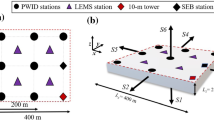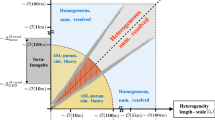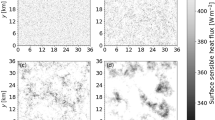Abstract
Experimental closure of the surface energy balance during convective periods is a long-standing problem. With experimental data from the Idealized horizontal Planar Array experiment for Quantifying Surface heterogeneity, the terms of the temperature-tendency equation are computed, with an emphasis on the total derivative. The experiment occurred at the Surface Layer Turbulence and Environmental Science Test facility at the U.S. Army Dugway Proving Ground during the summer of 2019. The experimental layout contained an array of 21 flux stations over a 1 km\(^2\) grid. Sensible heat fluxes show high spatial variability, with maximum variability occurring during convective periods. Maximum variability in the vertical heat flux is 50–80 W m\(^{-2}\) (median variability of 40%), while in the horizontal flux, it is 200–500 W m\(^{-2}\) (median variability of 48% for the streamwise and 40% for the spanwise fluxes). Ensemble averages computed during convective afternoon periods show large magnitudes of horizontal advection (48 W m\(^{-3}\) or 172 K h\(^{-1}\)) and vertical flux divergence (13 W m\(^{-3}\) or 47 K h\(^{-1}\)). Probability density functions of the total derivative from convective cases show mean volumetric heating rates of 43 W m\(^{-3}\) (154 K h\(^{-1}\)) compared to 13 W m\(^{-3}\) (47 K h\(^{-1}\)) on non-convective days. A conceptual model based on persistent mean flow structures from local-surface-temperature heterogeneities may explain the observed advection. The model describes the difference between locally-driven advection and advection driven by larger-scale forcings. Of the cases examined, 83% with streamwise and 81% with spanwise advection during unstable periods are classified as locally driven by nearby surface thermal heterogeneities.














Similar content being viewed by others
References
Alfieri JG, Kustas WP, Prueger JH, Hipps LE, Evett SR, Basara JB, Neale CM, French AN, Colaizzi P, Agam N, Cosh MH, Chavez JL, Howell TA (2012) On the discrepancy between eddy covariance and lysimetry-based surface flux measurements under strongly advective conditions. Adv Water Resour 50:62–78. https://doi.org/10.1016/j.advwatres.2012.07.008
AMS (2012) Convection: American Meteorology Society Glossary
Aubinet M, Heinesch B, Yernaux M (2003) Horizontal and vertical CO\(_2\) advection in a sloping forest. Boundary-Layer Meteorol 108:397–417
Aubinet M, Berbigier P, Bernhofer C, Cescatti A, Feigenwinter C, Granier A, Gru T, Havrankova K, Heinesch B, Longdoz B, Marcolla B, Montagnani L, Sedlak P (2005) Comparing CO\(_2\) storage and advection conditions at night at different carboeuroflux sites. Boundary-Layer Meteorol 116:63–94. https://doi.org/10.1007/s10546-004-7091-8
Aubinet M, Feigenwinter C, Heinesch B, Bernhofer C, Canepa E, Lindroth A, Montagnani L, Rebmann C, Sedlak P, Van Gorsel E (2010) Direct advection measurements do not help to solve the night-time CO\(_2\) closure problem: evidence from three different forests. Agric For Meteorol 150(5):655–664. https://doi.org/10.1016/j.agrformet.2010.01.016
Blyth E, Gash J, Lloyd A, Pryor M, Weedon GP, Shuttleworth J (2010) Evaluating the JULES land surface model energy fluxes using FLUXNET data. J Hydrometeorol 11(2):509–519. https://doi.org/10.1175/2009JHM1183.1
Cuxart J, Conangla L, Jiménez MA (2015) Evaluation of the surface energy budget equation with experimental data and the ECMWF model in the Ebro Valley. J Geophys Res Atmos 120(3):1008–1022. https://doi.org/10.1002/2014JD022296
Cuxart J, Wrenger B, Martínez-Villagrasa D, Reuder J, Jonassen MO, Jiménez MA, Lothon M, Lohou F, Hartogensis O, Dünnermann J, Conangla L, Garai A (2016) Estimation of the advection effects induced by surface heterogeneities in the surface energy budget. Atmos Chem Phys 16(14):9489–9504. https://doi.org/10.5194/acp-16-9489-2016
Feigenwinter C, Bernhofer C, Vogt R (2004) The influence of advection on the short term CO\(_2\)-budget in and above a forest canopy. Boundary-Layer Meteorol 113(2):201–224. https://doi.org/10.1023/B:BOUN.0000039372.86053.ff
Figuerola PI, Berliner PR (2005) Evapotranspiration under advective conditions. Int J Biometeorol 49(6):403–416. https://doi.org/10.1007/s00484-004-0252-0
Finnigan JJ, Clement R, Malhi Y, Leuning R, Cleugh H (2003) A re-evaluation of long-term flux measurement techniques part i: averaging and coordinate rotation. Boundary-Layer Meteorol 107(1):1–48. https://doi.org/10.1023/A:1021554900225
Foken T (2008) The energy balance closure problem: an overview. Ecol Appl 18(6):1351–1367. https://doi.org/10.1890/06-0922.1
Foken T, Aubinet M, Finnigan JJ, Leclerc MY, Mauder M, Paw UKT (2011) Results of a panel discussion about the energy balance closure correction for trace gases. Bull Am Meteorol Soc 92(4):ES13–ES18. https://doi.org/10.1175/2011BAMS3130.1
Gao Z, Liu H, Russell ES, Huang J, Foken T, Oncley SP (2016) Large eddies modulating flux convergence and divergence in a disturbed unstable atmospheric surface layer. J Geophys Res Atmos 121(4):1475–1492. https://doi.org/10.1002/2015JD024529
Gao Z, Liu H, Katul GG, Foken T (2017) Non-closure of the surface energy balance explained by phase difference between vertical velocity and scalars of large atmospheric eddies. Environ Res Lett 12(3):034025. https://doi.org/10.1088/1748-9326/aa625b
Garcia-Santos V, Cuxart J, Jimenez MA, Martinez-Villagrasa D, Simo G, Picos R, Caselles V (2019) Study of temperature heterogeneities at sub-kilometric scales and influence on surface-atmosphere energy interactions. IEEE Trans Geosci Remote Sens 57(2):640–654. https://doi.org/10.1109/TGRS.2018.2859182
Grachev AA, Fairall CW, Blomquist BW, Fernando HJ, Leo LS, Otárola-Bustos SF, Wilczak JM, McCaffrey KL (2020) On the surface energy balance closure at different temporal scales. Agric For Meteorol. https://doi.org/10.1016/j.agrformet.2019.107823
Gunawardena N, Pardyjak E, Stoll R, Khadka A (2018) Development and evaluation of an open-source, low-cost distributed sensor network for environmental monitoring applications. Meas Sci Technol 29(2):024008
Hang C, Jensen D, Hoch S, Paryjak ER (2016) Playa soil moisture and evaporation dynamics during the materhorn field program. Boundary-Layer Meteorol 3:521–538. https://doi.org/10.1007/s10546-015-0058-0
Heusinkveld B, Jacobs A, Holtslag A, Berkowicz S (2004) Surface energy balance closure in an arid region: role of soil heat flux. Agric For Meteorol 122(1):21–37. https://doi.org/10.1016/j.agrformet.2003.09.005
Higgins CW (2012) A-posteriori analysis of surface energy budget closure to determine missed energy pathways. Geophys Res Lett. https://doi.org/10.1029/2012GL052918
Higgins CW, Pardyjak E, Froidevaux M, Simeonov V, Parlange MB (2013) Measured and estimated water vapor advection in the atmospheric surface layer. J Hydrometeorol 14(6):1966–1972. https://doi.org/10.1175/JHM-D-12-0166.1
Huang YC, Brunner C, Pardyjak E, Hultmark M (2018) Simultaneous and well-resolved velocity and temperature measurements in the atmospheric surface layer. In: American geophysical union fall meeting
Inagaki A, Letzel MO, Raasch S, Kanda M (2006) Impact of surface heterogeneity on energy imbalance: a study using LES. J Meteorol Soc Jpn 84(1):187–198. https://doi.org/10.2151/jmsj.84.187
Iungo G, Najafi B, Puccionio M, Hoch S, Calaf M, Pardyjak E (2018) Detection and characterization of very-large-scale motions in the atmospheric surface layer through wind lidar measurements. In: American geophysical union fall meeting
Jeglum ME (2016) Multiscale flow interactions in the complex terrain of northwestern Utah. PhD thesis, University of Utah
Jensen DD, Nadeau DF, Hoch SW, Pardyjak ER (2016) Observations of near-surface heat-flux and temperature profiles through the early evening transition over contrasting surfaces. Boundary-Layer Meteorol 159:567–587
Kanda M, Inagaki A, Letzel MO, Raasch S, Watanabe T (2004) LES study of the energy imbalance problem with eddy covariance fluxes. Boundary-Layer Meteorol 110(3):381–404. https://doi.org/10.1023/B:BOUN.0000007225.45548.7a
Katul G, Hsieh CI, David Bowling K, Clark Shurpali N, Turnipseed A, Albertson J, Tu K, Hollinger D, Evans B, Offerle B, Anderson D, Ellsworth D, Vogel C, Oren R (1999) Spatial variability of turbulent fluxes in the roughness sublayer of an even-aged pine forest. Boundary-Layer Meteorol 93(1):1–28. https://doi.org/10.1023/A:1002079602069
Mahrt L (1999) Stratified atmospheric boundary layers. Boundary-Layer Meteorol 90(3):375–396. https://doi.org/10.1023/A:1001765727956
Mahrt L, Thomas CK, Grachev AA, Persson POG (2018) Near-surface vertical flux divergence in the stable boundary layer. Boundary-Layer Meteorol 169:373–393. https://doi.org/10.1007/s10546-018-0379-x
Malek E (2003) Microclimate of a desert playa: evaluation of annual radiation, energy, and water budgets components. Int J Climatol 23:333–345
Margairaz F, Pardyjak ER, Calaf M (2020) Surface thermal heterogeneities and the atmospheric boundary layer: the relevance of dispersive fluxes. Boundary-Layer Meteorol 175(3):369–395. https://doi.org/10.1007/s10546-020-00509-w
Metzger M (2002) Scalar dispersion in high Reynolds number turbulent boundary layers. PhD thesis, University of Utah
Meyers T, Hollinger S (2004) An assessment of storage terms in the surface energy balance of maize and soybean. Agric For Meteorol 125:105–115. https://doi.org/10.1016/j.agrformet.2004.03.001
Moderow U, Feigenwinter C, Bernhofer C (2007) Estimating the components of the sensible heat budget of a tall forest canopy in complex terrain. Boundary-Layer Meteorol 123(1):99–120. https://doi.org/10.1007/s10546-006-9136-7
Morrison TJ, Calaf M, Fernando HJS, Price TA, Pardyjak ER (2017) A methodology for computing spatially and temporally varying surface sensible heat flux from thermal imagery. Q J R Meteorol Soc 143(707):2616–2624. https://doi.org/10.1002/qj.3112
Nakamura R, Mahrt L (2006) Vertically integrated sensible-heat budgets for stable nocturnal boundary layers. Q J R Meteorol Soc 132(615):383–403. https://doi.org/10.1256/qj.05.50
Nieuwstadt FTM (1984) The turbulent structure of the stable, nocturnal boundary layer. J Atmos Sci 41(14):2202–2216. https://doi.org/10.1175/1520-0469(1984)041<2202:TTSOTS>2.0.CO;2
Oliphant A, Grimmond C, Zutter H, Schmid H, Su HB, Scott S, Offerle B, Randolph JC, Ehman J (2004) Heat storage and energy balance fluxes for a temperate deciduous forest. Agric For Meteorol 126:185–201. https://doi.org/10.1016/j.agrformet.2004.07.003
Oncley SP, Foken T, Vogt R, Kohsiek W, DeBruin HA, Bernhofer C, Christen A, van Gorsel E, Grantz D, Feigenwinter C, Lehner I, Liebethal C, Liu H, Mauder M, Pitacco A, Ribeiro L, Weidinger T (2007) The energy balance experiment EBEX-2000. Part I: overview and energy balance. Boundary-Layer Meteorol 123(1):1–28. https://doi.org/10.1007/s10546-007-9161-1
Panin G, Tetzlaff G, Raabe A (1998) Inhomogeneity of the land surface and problems in the parameterization of surface fluxes in natural conditions. Theor Appl Climatol 60:163–178. https://doi.org/10.1007/s007040050041
Prueger J, Hipps L, Cooper D (1996) Evaporation and the development of the local boundary layer over an irrigated surface in an arid region. Agric For Meteorol 78(3):223–237. https://doi.org/10.1016/0168-1923(95)02234-1
Steinfeld G, Raasch S, Markkanen T (2008) Footprints in homogeneously and heterogeneously driven boundary layers derived from a Lagrangian stochastic particle model embedded into large-eddy simulation. Boundary-Layer Meteorol 129(2):225–248. https://doi.org/10.1007/s10546-008-9317-7
Stull RB (1988) An introduction to boundary layer meteorology. Kluwer Academic Publishers, Dordrecht
USGS (2018) NAIP plus 7.5 of Granite Peak NW. https://viewer.nationalmap.gov/basic/
Vickers D, Mahrt L (1997) Quality control and flux sampling problems for tower and aircraft data. J Atmos Ocean Technol 14:512–526
Vickers D, Mahrt L (2003) The cospectral gap and turbulent flux calculations. J Atmos Ocean Technol 20(5):660–672. https://doi.org/10.1175/1520-0426(2003)20<660:TCGATF>2.0.CO;2
Whiteman C (2000) Mountain meteorology: fundamentals and applications. Oxford University Press, New York
Wilczak JM, Oncley SP, Stage SA (2001) Sonic anemometer tilt correction algorithms. Boundary-Layer Meteorol 99(1):127–150. https://doi.org/10.1023/A:1018966204465
Williams M, Richardson AD, Reichstein M, Stoy PC, Peylin P, Verbeeck H, Carvalhais N, Jung M, Hollinger DY, Kattge J, Leuning R, Luo Y, Tomelleri E, Trudinger CM, Wang YP (2009) Improving land surface models with FLUXNET data. Biogeosciences 6(7):1341–1359. https://doi.org/10.5194/bg-6-1341-2009
Wilson K, Goldstein A, Falge E, Aubinet M, Baldocchi D, Berbigier P, Bernhofer C, Ceulemans R, Dolman H, Field C, Grelle A, Ibrom A, Law B, Kowalski A, Meyers T, Moncrieff J, Monson R, Oechel W, Tenhunen J, Valentini R, Verma S (2002) Energy balance closure at FLUXNET sites. Agric For Meteorol 113(1–4):223–243. https://doi.org/10.1016/S0168-1923(02)00109-0
Xu K, Pingintha-Durden N, Luo H, Durden D, Desai AR, Florian C, Metzger S (2019) The eddy-covariance storage term in air: consistent community resources improve flux measurement reliability. Agric For Meteorol 279(107):734. https://doi.org/10.1016/j.agrformet.2019.107734
Zhang Y, Liu H, Foken T, Williams QL, Liu S, Mauder M, Liebethal C (2010) Turbulence spectra and cospectra under the influence of large eddies in the Energy Balance EXperiment (EBEX). Boundary-Layer Meteorol 136(2):235–251. https://doi.org/10.1007/s10546-010-9504-1
Acknowledgements
This research was accomplished via the support of the U.S. National Science Foundation grant number PDM-1649067. Marc Calaf also acknowledges the Mechanical Engineering Department at University of Utah for start-up funds. The authors are also thankful to the U.S. Army Dugway Proving Ground for their gracious assistance and for providing the experimental test bed. The authors declare no conflict of interest.
Author information
Authors and Affiliations
Corresponding author
Additional information
Publisher's Note
Springer Nature remains neutral with regard to jurisdictional claims in published maps and institutional affiliations.
Appendix 1: Temperature Correction
Appendix 1: Temperature Correction
Given the anticipated errors during in situ temperature-data acquisition (panel temperature error, thermocouple error, thermocouple voltage measurement error, noise error, thermocouple polynomial error, and reference junction error), we have determined that an a posteriori temperature collocation manages these errors. Please see the Campbell Scientific CR1000 data-logger manual, pp. 343–352 for more information on these errors. Note that these are errors which arise from utilizing research-grade instruments and a temperature collocation should always be considered during future advection experiments. This methodology utilizes a second-order polynomial fit over two weeks of data between a set of truth measurements and a set of values needing correction. This method seeks to only correct systemic error to correct for temperature differences between stations and does not aid in finding the absolute temperatures. A second-order polynomial is selected for the correction since the errors are nonlinear across the temperatures observed during data acquisition. For our purposes, we utilized the central high-resolution-array tower as our truth tower due to its proximity to the towers utilized in the horizontal advection measurement. However, its temperature is not used in performing the temperature derivative. Thus the assumption is that over the 30 min, the towers should converge to the truth tower.
An example of the temperature correction is observed in Fig. 15, which presents the 30-min-averaged truth temperatures against the temperature from the southern tower at the high-resolution array (10-m south from the truth measurements). The black circles denote the raw data, where the nonlinear trend across temperatures shows the extremes converging and the mid-valued temperatures showing the worst agreement. The black line illustrates a one-to-one fit. Meanwhile, the red line shows the parabolic fit to the data. The minimum \(R^2\) value across all towers is 0.994, suggesting the parabolic fit works well without a dataset. Finally, the blue stars show the corrected temperature used for the computation of Eq. 2b. Note that this correction does not change the turbulent quantities and only works under cases where the absolute temperature is not needed for the final solution. Furthermore, for future applications, if the truth temperature was validated over a range of values observed during the experiment, then the absolute temperature could be calculated.
An example of the 30-min averaged fine-wire temperatures from the centre high-resolution array tower (\(T_{truth}\)) against the south high-resolution array tower (\(T_{fit}\)). The black circles correspond to the raw data, where errors compile with a temperature dependency to create non-linear differences between observations. The blue stars illustrate the data with the correction applied. Each tower used in this analysis underwent the correction with the centre high-resolution array tower
Rights and permissions
About this article
Cite this article
Morrison, T., Calaf, M., Higgins, C.W. et al. The Impact of Surface Temperature Heterogeneity on Near-Surface Heat Transport. Boundary-Layer Meteorol 180, 247–272 (2021). https://doi.org/10.1007/s10546-021-00624-2
Received:
Accepted:
Published:
Issue Date:
DOI: https://doi.org/10.1007/s10546-021-00624-2





